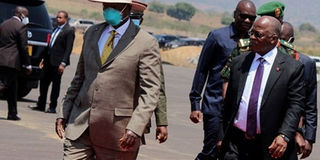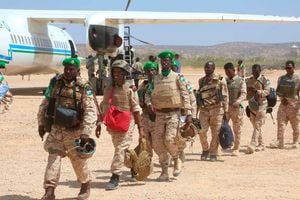How Magufuli charmed Uganda

Tanzanian President John Magufuli (R) and Ugandan President Yoweri Museveni endorsed the construction of the East Africa Crude Oil Pipeline (EACOP. PHOTO/FILE
What you need to know:
- Six years ago, there existed a loose grouping christened the ‘coalition of the willing’, established in 2013 and comprising Kenya, Rwanda and Uganda and to some extent South Sudan.
At the onset of John Pompe Magufuli’s Tanzania presidency in 2015, the East African Community (EAC), which then comprised Uganda, Kenya, Tanzania, Burundi and Rwanda, was not in the best of political health.
Six years ago, there existed a loose grouping christened the ‘coalition of the willing’, established in 2013 and comprising Kenya, Rwanda and Uganda and to some extent South Sudan.
It was birthed through the Northern Corridor Integration Projects (NCIP) scheme under which the states committed to work together on joint infrastructure projects. Among the flagship projects was the Standard Gauge Railway (SGR).
Tanzania, alongside Ethiopia, Burundi and the Democratic Republic of Congo (DRC), were eventually invited to the NCIP table as observers.
During the first years of his presidency, Magufuli appeared less enthusiastic and engaged about NCIP that in many ways mirrored the EAC itself.
Then boom! Total E&P started fast-tracking plans to construct an oil pipeline to evacuate Uganda’s waxy crude oil to the international market, either through Mombasa and Lamu, both in Kenya, or the southern route to Tanzania.
Kenya has been, and remains, Uganda’s main gateway to the sea; so the it appeared destined as the country over whose land Uganda’s oil pipeline connecting to the coast would run.
However, a study by Gulf Interstate Engineering detailed that the southern route — from Hoima via Mutukula to Tanga — was more viable and less challenging a terrain to get oil from Uganda to the international market.
Total E&P endorsed the study as did Ugandan technocrats. It marked Uganda’s abrupt turn away from the allure of Kenya, much to the chagrin of leaders there.
The Tanzania route deal was closed in 2016, sealed in 2017 and stamped in 2020. A meeting scheduled for next Monday to sign the Stakeholders, Tariff and Transportation agreements now hangs in balance following Magufuli’s sudden death since Tanzanian Vice President Samia Suluhu Hassan was expected to join Total executives and President Museveni in Kampala.
While appearing before the parliamentary committee on national economy, Uganda’s Energy minister Goretti Kitutu said the Monday meeting is still on schedule, but it remains unclear if Tanzanian delegation will attend, considering that the country has declared two weeks of mourning.
Love for pipeline project
Magufuli personally threw weight behind the 1,443km crude oil pipeline project and ensured related decisions were fast-tracked, and the Tanzanian technocrats always blamed the delays on their Ugandan counterparts.
In late 2019 as President Museveni haggled with the oil companies over tax issues that slowed progress of the pipeline, Magufuli, during the Uganda-Tanzania business forum, told his counterpart to sacrifice some short-term tax benefits with the hope of getting long-term benefits from the oil pipeline.
“Sacrifice some of the short-term gains for the long-term and your Uganda Revenue Authority (URA) officials should not delay you, actually we wanted this pipeline to be named Kaguta Pipeline when it opens,” Magufuli said then.
During his roughly six years’ presidency, Magufuli visited Uganda thrice; for President Museveni’s swearing in in May 2016, laying of the oil pipeline’s foundation stone in in Rakai in November 2017, and for the 19th EAC Ordinary summit. He travelled by road.
Upon Uganda choosing Tanzania for the oil pipeline route, the NCIP gradually lost steam, particularly after relations between Uganda and Rwanda and their leaders Museveni and Paul Kagame turned frosty. The last NCIP heads of state meeting took place in Nairobi in 2018.
In 2016, Magufuli elected to have his country build its own SGR linking to Lake Victoria port of Mwanza. With the NCIP in comatose, Rwanda expressed willingness to link their proposed SGR via Tanzania rather than Kampala, which discussions are ongoing.
Later in March 2017, Mr Museveni, during a visit to Tanzania, learnt that Uganda’s proposed SGR appeared much more expensive than that of Tanzania. Every kilometre of rail, Mr Museveni was reportedly told, was costing Tanzania $1.5m (Shs5.6b) while Uganda’s was set to cost $7.3m (Shs25b) per kilometre.
Mr Museveni’s interest in the Tanzania route was whetted by Tanzania’s proposal to prioritise the 1,219km SGR line from Dar es Salaam to Mwanza port to revive inland water transport on Lake Victoria.
Upon return, Mr Museveni directed the then Works minister Monica Azuba Ntege to undertake independent studies on the costs of Uganda’s SGR. The back-to-back studies by a team led by Prof Edward Rugumayo and another by Eng Badru Kiggundu, contradicted each other and kicked up a storm at Uganda’s SGR office.
[email protected]




